Giorgos Tolias
INRIA
Attention, Please! Revisiting Attentive Probing for Masked Image Modeling
Jun 11, 2025Abstract:As fine-tuning (FT) becomes increasingly impractical at scale, probing is emerging as the preferred evaluation protocol for self-supervised learning (SSL). Yet, the standard linear probing (LP) fails to adequately reflect the potential of models trained with Masked Image Modeling (MIM), due to the distributed nature of patch tokens. This motivates the need for attentive probing, an alternative that uses attention to selectively aggregate patch-level features. Despite its growing adoption, attentive probing remains under-explored, with existing methods suffering from excessive parameterization and poor computational efficiency. In this work, we revisit attentive probing through the lens of the accuracy-efficiency trade-off. We conduct a systematic study of existing methods, analyzing their mechanisms and benchmarking their performance. We introduce efficient probing (EP), a multi-query cross-attention mechanism that eliminates redundant projections, reduces the number of trainable parameters, and achieves up to a 10$\times$ speed-up over conventional multi-head attention. Despite its simplicity, EP outperforms LP and prior attentive probing approaches across seven benchmarks, generalizes well beyond MIM to diverse pre-training paradigms, produces interpretable attention maps, and achieves strong gains in low-shot and layer-wise settings. Code available at https://github.com/billpsomas/efficient-probing.
A Dataset for Semantic Segmentation in the Presence of Unknowns
Mar 28, 2025Abstract:Before deployment in the real-world deep neural networks require thorough evaluation of how they handle both knowns, inputs represented in the training data, and unknowns (anomalies). This is especially important for scene understanding tasks with safety critical applications, such as in autonomous driving. Existing datasets allow evaluation of only knowns or unknowns - but not both, which is required to establish "in the wild" suitability of deep neural network models. To bridge this gap, we propose a novel anomaly segmentation dataset, ISSU, that features a diverse set of anomaly inputs from cluttered real-world environments. The dataset is twice larger than existing anomaly segmentation datasets, and provides a training, validation and test set for controlled in-domain evaluation. The test set consists of a static and temporal part, with the latter comprised of videos. The dataset provides annotations for both closed-set (knowns) and anomalies, enabling closed-set and open-set evaluation. The dataset covers diverse conditions, such as domain and cross-sensor shift, illumination variation and allows ablation of anomaly detection methods with respect to these variations. Evaluation results of current state-of-the-art methods confirm the need for improvements especially in domain-generalization, small and large object segmentation.
LOCORE: Image Re-ranking with Long-Context Sequence Modeling
Mar 27, 2025Abstract:We introduce LOCORE, Long-Context Re-ranker, a model that takes as input local descriptors corresponding to an image query and a list of gallery images and outputs similarity scores between the query and each gallery image. This model is used for image retrieval, where typically a first ranking is performed with an efficient similarity measure, and then a shortlist of top-ranked images is re-ranked based on a more fine-grained similarity measure. Compared to existing methods that perform pair-wise similarity estimation with local descriptors or list-wise re-ranking with global descriptors, LOCORE is the first method to perform list-wise re-ranking with local descriptors. To achieve this, we leverage efficient long-context sequence models to effectively capture the dependencies between query and gallery images at the local-descriptor level. During testing, we process long shortlists with a sliding window strategy that is tailored to overcome the context size limitations of sequence models. Our approach achieves superior performance compared with other re-rankers on established image retrieval benchmarks of landmarks (ROxf and RPar), products (SOP), fashion items (In-Shop), and bird species (CUB-200) while having comparable latency to the pair-wise local descriptor re-rankers.
LPOSS: Label Propagation Over Patches and Pixels for Open-vocabulary Semantic Segmentation
Mar 25, 2025Abstract:We propose a training-free method for open-vocabulary semantic segmentation using Vision-and-Language Models (VLMs). Our approach enhances the initial per-patch predictions of VLMs through label propagation, which jointly optimizes predictions by incorporating patch-to-patch relationships. Since VLMs are primarily optimized for cross-modal alignment and not for intra-modal similarity, we use a Vision Model (VM) that is observed to better capture these relationships. We address resolution limitations inherent to patch-based encoders by applying label propagation at the pixel level as a refinement step, significantly improving segmentation accuracy near class boundaries. Our method, called LPOSS+, performs inference over the entire image, avoiding window-based processing and thereby capturing contextual interactions across the full image. LPOSS+ achieves state-of-the-art performance among training-free methods, across a diverse set of datasets. Code: https://github.com/vladan-stojnic/LPOSS
ILIAS: Instance-Level Image retrieval At Scale
Feb 17, 2025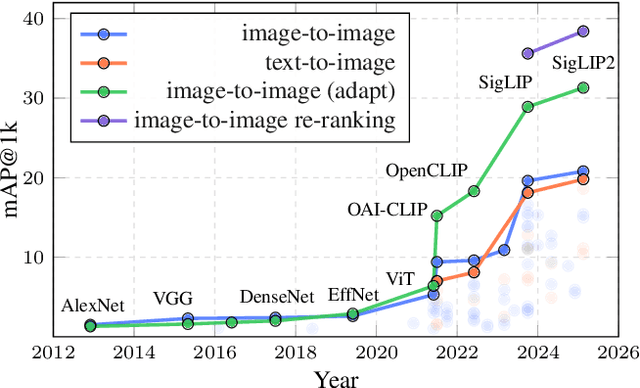
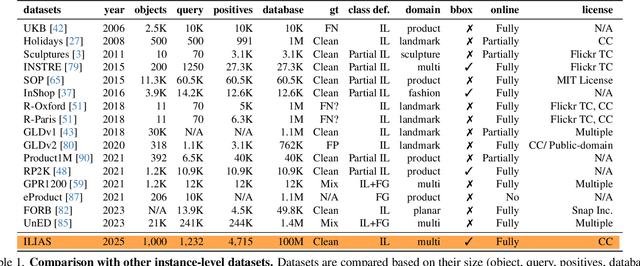
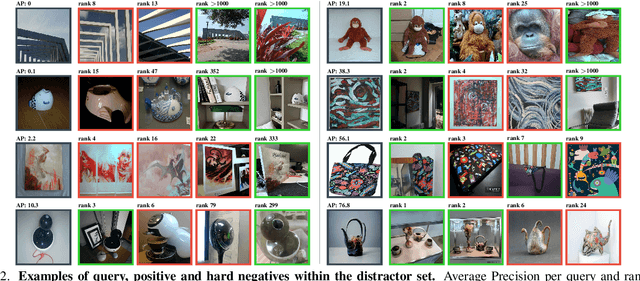
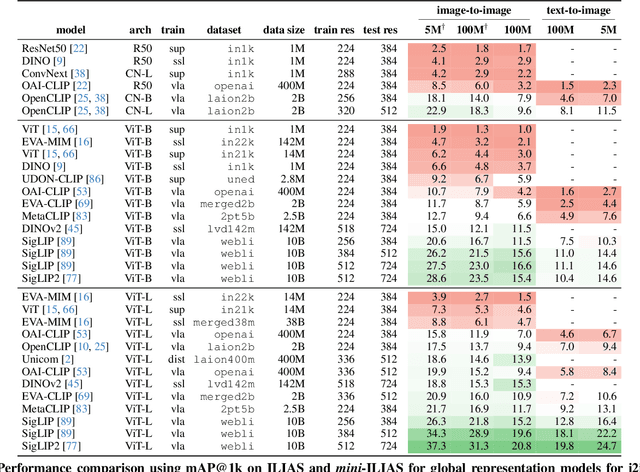
Abstract:This work introduces ILIAS, a new test dataset for Instance-Level Image retrieval At Scale. It is designed to evaluate the ability of current and future foundation models and retrieval techniques to recognize particular objects. The key benefits over existing datasets include large scale, domain diversity, accurate ground truth, and a performance that is far from saturated. ILIAS includes query and positive images for 1,000 object instances, manually collected to capture challenging conditions and diverse domains. Large-scale retrieval is conducted against 100 million distractor images from YFCC100M. To avoid false negatives without extra annotation effort, we include only query objects confirmed to have emerged after 2014, i.e. the compilation date of YFCC100M. An extensive benchmarking is performed with the following observations: i) models fine-tuned on specific domains, such as landmarks or products, excel in that domain but fail on ILIAS ii) learning a linear adaptation layer using multi-domain class supervision results in performance improvements, especially for vision-language models iii) local descriptors in retrieval re-ranking are still a key ingredient, especially in the presence of severe background clutter iv) the text-to-image performance of the vision-language foundation models is surprisingly close to the corresponding image-to-image case. website: https://vrg.fel.cvut.cz/ilias/
Three Things to Know about Deep Metric Learning
Dec 17, 2024Abstract:This paper addresses supervised deep metric learning for open-set image retrieval, focusing on three key aspects: the loss function, mixup regularization, and model initialization. In deep metric learning, optimizing the retrieval evaluation metric, recall@k, via gradient descent is desirable but challenging due to its non-differentiable nature. To overcome this, we propose a differentiable surrogate loss that is computed on large batches, nearly equivalent to the entire training set. This computationally intensive process is made feasible through an implementation that bypasses the GPU memory limitations. Additionally, we introduce an efficient mixup regularization technique that operates on pairwise scalar similarities, effectively increasing the batch size even further. The training process is further enhanced by initializing the vision encoder using foundational models, which are pre-trained on large-scale datasets. Through a systematic study of these components, we demonstrate that their synergy enables large models to nearly solve popular benchmarks.
Composed Image Retrieval for Training-Free Domain Conversion
Dec 04, 2024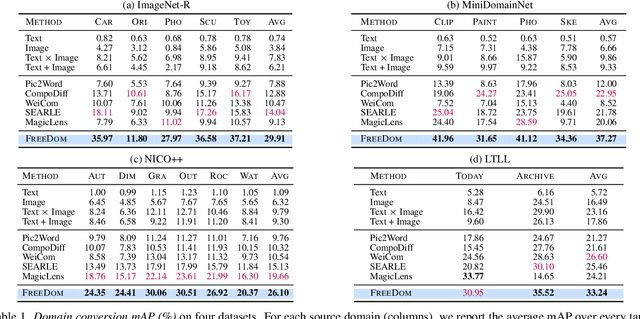
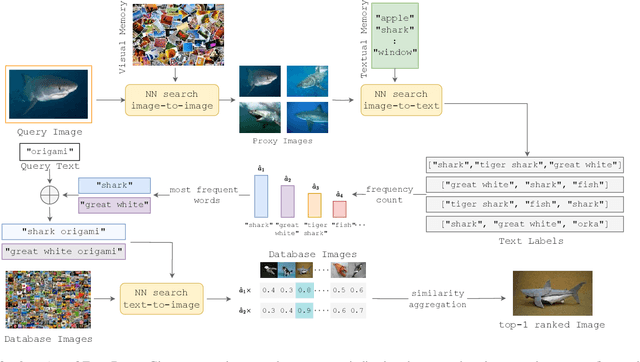


Abstract:This work addresses composed image retrieval in the context of domain conversion, where the content of a query image is retrieved in the domain specified by the query text. We show that a strong vision-language model provides sufficient descriptive power without additional training. The query image is mapped to the text input space using textual inversion. Unlike common practice that invert in the continuous space of text tokens, we use the discrete word space via a nearest-neighbor search in a text vocabulary. With this inversion, the image is softly mapped across the vocabulary and is made more robust using retrieval-based augmentation. Database images are retrieved by a weighted ensemble of text queries combining mapped words with the domain text. Our method outperforms prior art by a large margin on standard and newly introduced benchmarks. Code: https://github.com/NikosEfth/freedom
Crafting Distribution Shifts for Validation and Training in Single Source Domain Generalization
Sep 29, 2024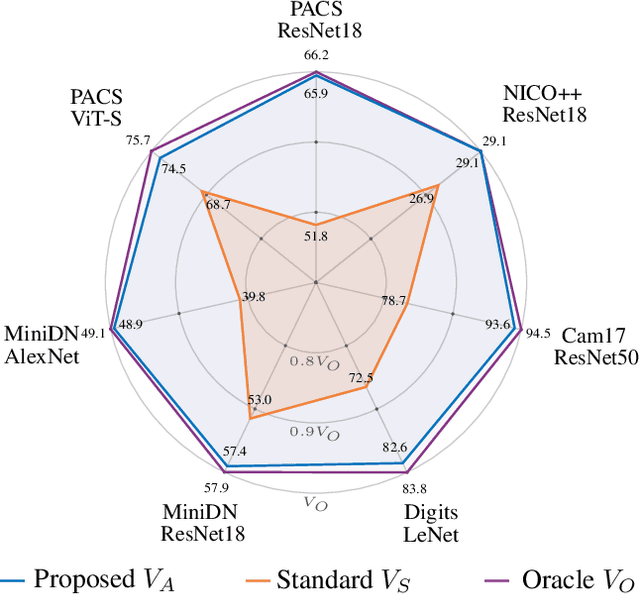
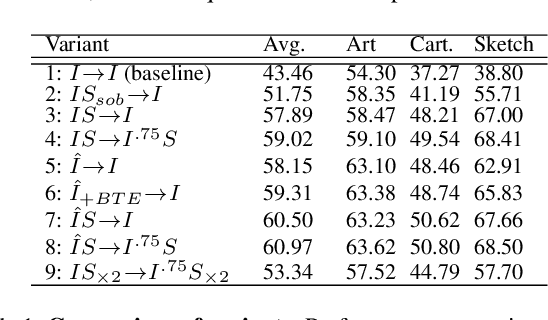

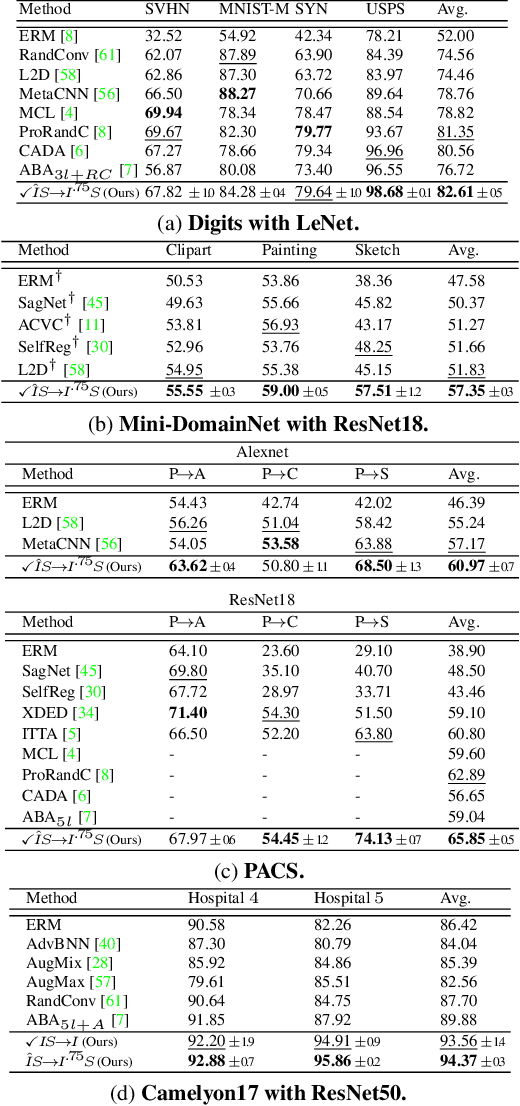
Abstract:Single-source domain generalization attempts to learn a model on a source domain and deploy it to unseen target domains. Limiting access only to source domain data imposes two key challenges - how to train a model that can generalize and how to verify that it does. The standard practice of validation on the training distribution does not accurately reflect the model's generalization ability, while validation on the test distribution is a malpractice to avoid. In this work, we construct an independent validation set by transforming source domain images with a comprehensive list of augmentations, covering a broad spectrum of potential distribution shifts in target domains. We demonstrate a high correlation between validation and test performance for multiple methods and across various datasets. The proposed validation achieves a relative accuracy improvement over the standard validation equal to 15.4% or 1.6% when used for method selection or learning rate tuning, respectively. Furthermore, we introduce a novel family of methods that increase the shape bias through enhanced edge maps. To benefit from the augmentations during training and preserve the independence of the validation set, a k-fold validation process is designed to separate the augmentation types used in training and validation. The method that achieves the best performance on the augmented validation is selected from the proposed family. It achieves state-of-the-art performance on various standard benchmarks. Code at: https://github.com/NikosEfth/crafting-shifts
AMES: Asymmetric and Memory-Efficient Similarity Estimation for Instance-level Retrieval
Aug 06, 2024Abstract:This work investigates the problem of instance-level image retrieval re-ranking with the constraint of memory efficiency, ultimately aiming to limit memory usage to 1KB per image. Departing from the prevalent focus on performance enhancements, this work prioritizes the crucial trade-off between performance and memory requirements. The proposed model uses a transformer-based architecture designed to estimate image-to-image similarity by capturing interactions within and across images based on their local descriptors. A distinctive property of the model is the capability for asymmetric similarity estimation. Database images are represented with a smaller number of descriptors compared to query images, enabling performance improvements without increasing memory consumption. To ensure adaptability across different applications, a universal model is introduced that adjusts to a varying number of local descriptors during the testing phase. Results on standard benchmarks demonstrate the superiority of our approach over both hand-crafted and learned models. In particular, compared with current state-of-the-art methods that overlook their memory footprint, our approach not only attains superior performance but does so with a significantly reduced memory footprint. The code and pretrained models are publicly available at: https://github.com/pavelsuma/ames
Composed Image Retrieval for Remote Sensing
May 29, 2024


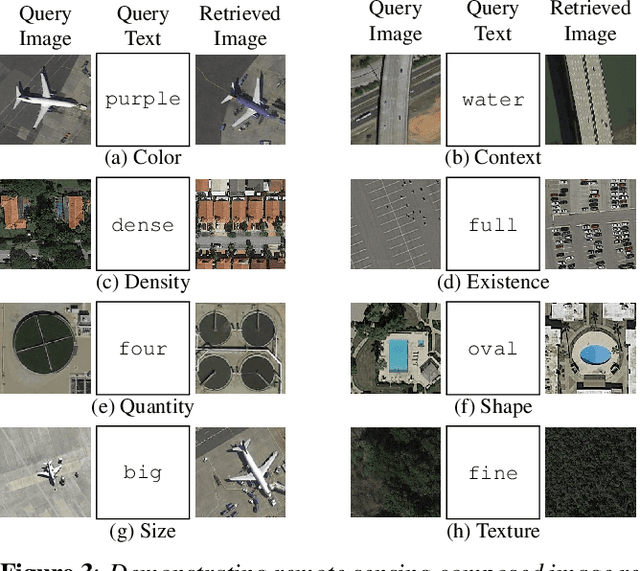
Abstract:This work introduces composed image retrieval to remote sensing. It allows to query a large image archive by image examples alternated by a textual description, enriching the descriptive power over unimodal queries, either visual or textual. Various attributes can be modified by the textual part, such as shape, color, or context. A novel method fusing image-to-image and text-to-image similarity is introduced. We demonstrate that a vision-language model possesses sufficient descriptive power and no further learning step or training data are necessary. We present a new evaluation benchmark focused on color, context, density, existence, quantity, and shape modifications. Our work not only sets the state-of-the-art for this task, but also serves as a foundational step in addressing a gap in the field of remote sensing image retrieval. Code at: https://github.com/billpsomas/rscir
 Add to Chrome
Add to Chrome Add to Firefox
Add to Firefox Add to Edge
Add to Edge